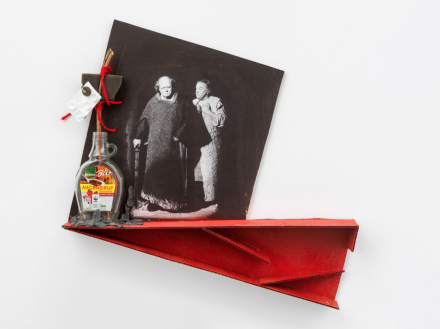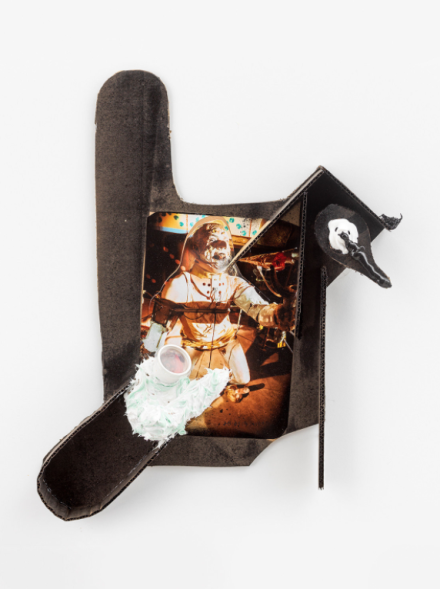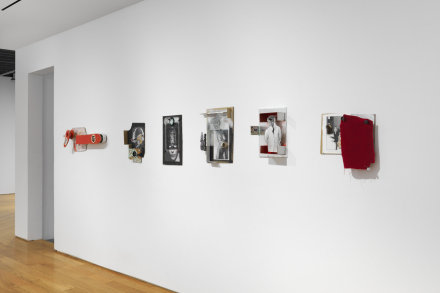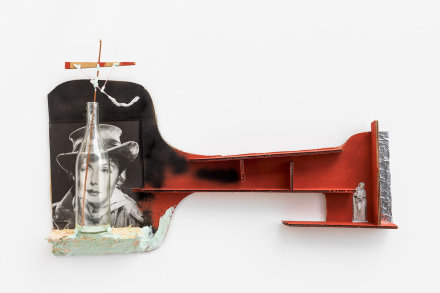
John Bock, Ohne Titel (2020), via Anton Kern
Taking on his tenth exhibition with Anton Kern Gallery, German sculptor and performance artist John Bock has turned towards a smaller scale, bringing out a series of 25 new three-dimensional collages that underscore his ongoing interests in the form and representation of performance and performers in modernity. While constructed out of simple materials, these works contain the entire Bockian universe, twisting a range of signifiers and iconographies into concise statements.

John Bock, Ohne Titel (2020), via Anton Kern
Titled Twilight Proximity Corpus, Bock’s show gathers a group of illustrious characters: Klaus Kinski, Greta Garbo, and Romy Schneider as a series of meditations on many iconic performers and actors that mingle alongside the artist’s own iconographies, twisted into a unified chorus with a range of fellow sculptors, models, and several of Bock’s own film protagonists. Presenting this range of artists and icons together his work reifies the body, not only as a container for these artists’ various ambitions and performative movements on screen and off, but equally for the auras that have been built up around them. The gallery trumpets the work as addressing “the softly glowing light from the sky after sunset, and… the state of obscurity and gradual decline that comes with it,” an intriguing note that seems to echo the notion of fame and “star-hood.” Theses figures irradiate their respective contexts in relation to the broader landscape of film and art, a marker of both persona and time.

John Bock, Twilight Proximity Corpus (Installation View), via Anton Kern
Bock’s process is simple. Collage is the guiding principle. Cardboard, photographs, and discarded common objects infused with silicone are the materials. The resulting wall-bound constructions resemble three-dimensional charts, models for set-ups in some arcane psycho-physical experiment, surrounding the collaged-in participants like mental stabilizers. Ritual, participation, and activation within these walls inform the narratives. The artist allows the viewer to enter a subjective space to experience a state of otherness, alienation, and transformation. In one piece, a photo-cut-out of Klaus Kinski in white blazer and black tie is enhanced with traces of glitter, an ominous cylindrical construction protruding from his forehead is mounted on a reflective surface and tightly braced by two cardboard brackets spray-painted red and white. Kinski, however, with his arms behind his back as if straightjacketed, appears severely restricted and uneasy inside the spatial structure. He stares pitifully at Bock’s expired ID card for some sort of revelation. Kinski, the notorious libertine, seems in deep distress. The artist manages to embrace his subject’s persona and personhood as part of his work, turning their construction within the public sphere into a material of its own.

John Bock, Ohne Titel (2020), via Anton Kern
Bock’s collages suggest that an artwork does not remain static but rather comes into being through the interplay of body and material. They are images of activated sculptures and allude to the artist’s own large participatory installations, performances, and films. The body, Bock suggests, becomes a medium in that it can transform life processes into images. The collages allow the viewers space in which to imaginatively explore what the activated work might look like, and to think about their own body in the artwork.
The show closes February 20th.
– C. Rhinehardt
Read more:
John Bock at Anton Kern [Exhibition Site]



